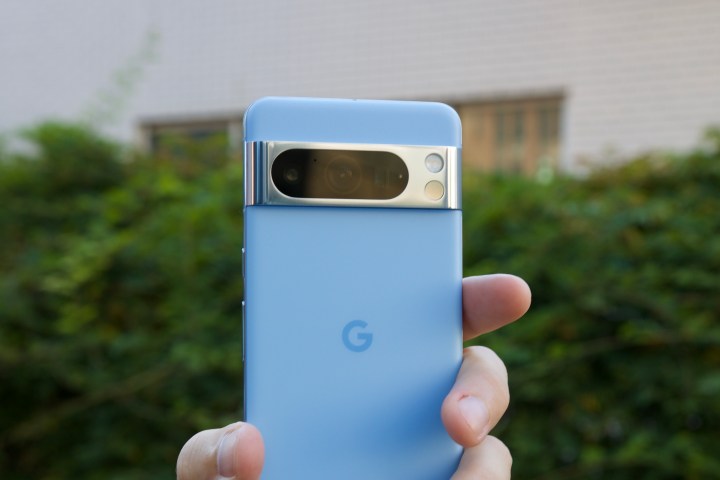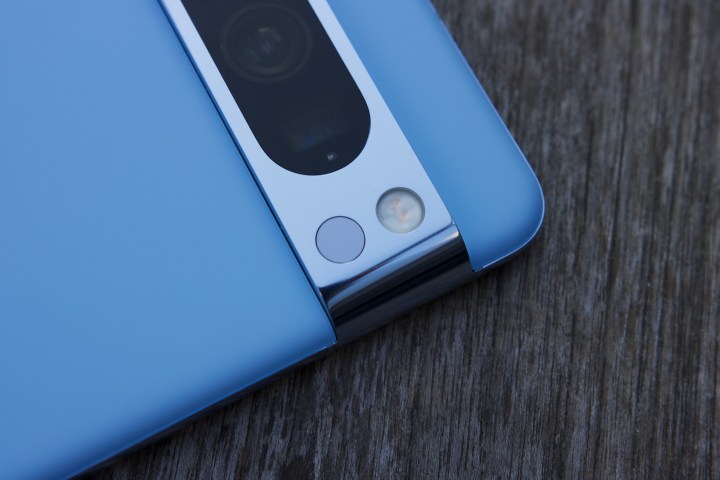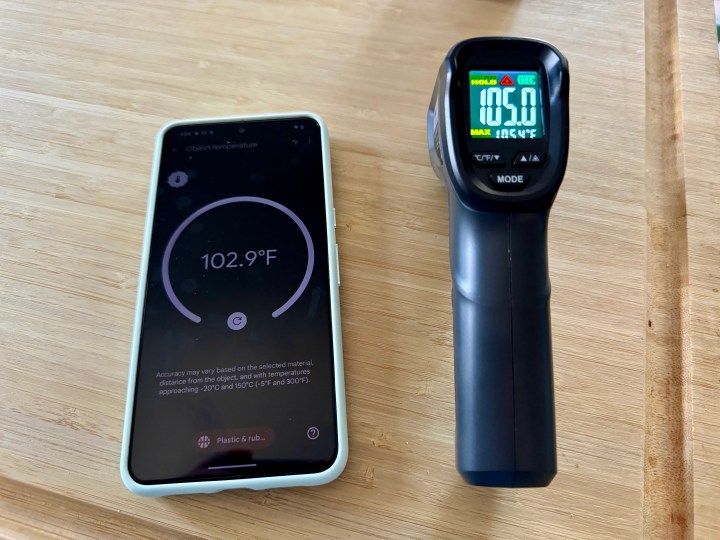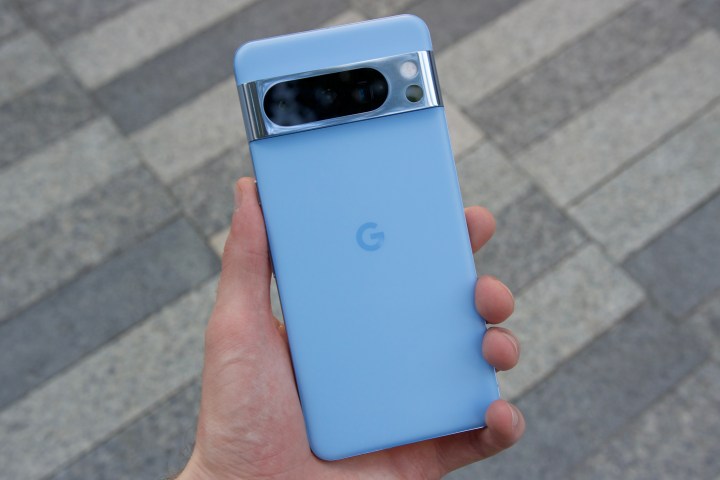
The “Made by Google event officially wrapped up last week, and we now have the next lineup of Pixel devices. This includes the Google Pixel 8 Pro, the regular Google Pixel 8, the Google Pixel Watch 2, and a couple of new colors for the Pixel Buds Pro.
With the Pixel 8 Pro, we have a lot of nice upgrades. This includes a new Super Actua LTPO OLED display that reaches 2,400 nits of peak brightness and has Corning Gorilla Glass Victus 2, the Tensor G3 chip, a slightly larger battery, and an improved camera system with 50MP main, 48MP ultrawide, and 48MP telephoto lenses.
One of the more interesting additions, though, is the Pixel 8 Pro’s temperature sensor located on the back of the phone, underneath the LED flash. So how does it work, and just how useful is it?
How does the temperature sensor on the Google Pixel 8 Pro work?

We’re not sure who was asking for a temperature sensor on their next smartphone, but Google apparently felt like it was a necessary addition for the Pixel 8 Pro. It’s located on the back of the Pixel 8 Pro, in the camera bar underneath the LED flash.
To use the temperature sensor, you’ll need the Pixel Thermometer app. When I received my review sample of the Pixel 8 Pro, the app wasn’t automatically installed, so I had to go into the default apps and download it manually.

When you launch the Thermometer app, it will tell you to point the sensor on the back of the phone within 5 centimeters or 2 inches of the object you’re measuring for best results (a pulsating icon on-screen helps you see where the sensor is). Then all you have to do is tap the giant “Tap to measure” button, and boom — you have a temperature reading.
The Thermometer app has a default setting that should work for any material you point it at. But Google does include the ability to choose a specific material if you intend to use the object temperature sensor for containers or the contents inside. These are the available materials to choose from:
- Food and organic
- Beverages and water
- Cast-iron
- Ceramic and glass
- Matte metal
- Shiny metal
- Plastic and rubber
- Fabric
- Wood
- Walls and windows
Picking a specific material may help with the accuracy of the temperature reading you get. For example, you may want to measure how hot your cast-iron pan is before throwing those steaks on it. Or maybe you’re curious about how cold your stainless steel tumbler is keeping your iced coffee. Or perhaps you’re curious about how hot your iPhone 15 Pro gets when it is so-called “overheating.”

I can’t say I ever wanted a temperature sensor on my phone before, and honestly, while it’s cool to check and say, “Hey, my phone can do this,” it just really seems like a gimmick.
This also seems like something that was thought of during the height of the pandemic in 2020, which would indicate how far back designs and features are thought of before being implemented into actual hardware. And while Google eventually plans to use the Pixel 8 Pro temperature sensor for measuring human temperatures, that won’t be implemented until it gets approval from the Food and Drug Administration (FDA). And it’s unclear when that will actually happen.
Is the Pixel 8 Pro temperature sensor accurate?

You may be wondering just how accurate this temperature sensor on the Pixel 8 Pro really is. I recently purchased an infrared temperature gun from Amazon when I was checking if an iPhone 14 Pro case actually helps regulate the temperature of your iPhone when using it. So, I decided I should put them head-to-head. For context, all of the below measurements are in Fahrenheit.
I measured my iPhone 15 Pro in an OtterBox Figura Series case right after having it charging up on a MagSafe charging stand for about 30 minutes. It was pretty warm, and the Pixel 8 Pro had a reading of 102.9 degrees, while my temperature gun read 105 degrees.

I also measured my stainless steel Starbucks tumbler with some iced coffee inside. I set the Pixel 8 Pro to “matte metal,” and it gave me a reading of 67.1 degrees, whereas the temperature gun read 72.3 degrees. On a separate occasion, I tried this again with the Pixel 8 Pro set to “Default,” and it gave me 71.6 degrees, while the temperature gun gave me 71.4 degrees.
Lastly, I decided to check how cold my refrigerator and freezer were. The Pixel 8 Pro gave me a freezer reading of 10 degrees when we have it set to 6 degrees, while the temperature gun read 12 degrees. I’m assuming it would be colder if I didn’t have the door open, of course. On the refrigerator side, it’s set to 40 degrees, and the Pixel 8 Pro said 42.1 degrees while the temperature gun said 45 degrees.

There are definitely some discrepancies with the Pixel 8 Pro’s temperature sensor compared to other devices. I’m not sure which one is actually right, but I’m going to lean toward the device that has the sole purpose of measuring temperatures, rather than the smartphone that has it tacked on for some reason.
The Pixel 8 Pro’s temperature sensor is strange

The Pixel 8 Pro’s temperature sensor would have been perfect two or three years ago when it was the new “normal” for places of business to take your temperature before you enter the building. But today, I feel like this is just an unnecessary extra that was added to the Pixel 8 Pro for no real reason other than being a gimmick to show off to people.
Besides, right now, the temperature sensor can only measure objects, as Google needs FDA approval for skin temperature measuring. How many times have you wanted to take the temperature of random objects on a daily basis? For me, it’s never really crossed my mind — yes, something is very hot or very cold, but I never wondered: “What is the exact temperature?”
Maybe you need to know the exact temperature of the pan before you throw your steak on for that perfect sear, but then again, based on the discrepancy of degrees with an infrared temperature gun, I’m not sure I can trust the numbers of the Pixel 8 Pro temperature sensor. For things like that, I’d probably just use something that is designed only for that purpose because it would be more accurate. It just feels like the Pixel 8 Pro temperature sensor is trying to make the Pixel 8 Pro a jack-of-all-trades and a master of none.
Sure, it’s something that you can show off to your friends as a neat trick: “But can your phone do this?” Otherwise, I don’t think this is something that I’ll be using regularly 0n the Pixel 8 Pro. Maybe once in a while, sure, but I think I’ll just stick with a dedicated thermometer — especially when it comes to human temperatures.
